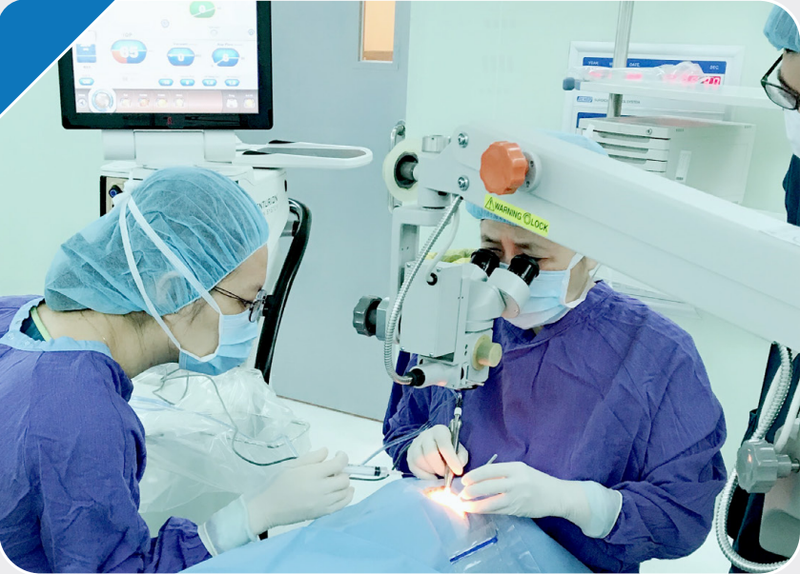Orbital fibromyalgia surgery
Orbital fibroids are difficult to diagnose and treat. Symptoms of the disease are easily confused with other eye diseases. It is only when the patient's vision is severely impaired or painful that he or she goes to the doctor, then the tumor has spread widely. Orbital fibromyalgia surgery will help patients limit the damage to certain eye functions.
1. What is orbital fibroma?
When tumors or tumors grow in the eye muscles, it will cause orbital fibroma. Ocular fibroids will cause complications such as protrusion, strabismus, reduction or even loss of vision.
Orbital fibroids have unclear symptoms and are easily confused with other eye diseases, so they are difficult to detect. However, protrusion is a common symptom in orbital fibroids. From the convex direction of the eye, it is possible to determine where the tumor is located. Usually, the slow-growing protrusion is usually due to a benign tumor, whereas the rapidly-growing protrusion is usually malignant.
Besides, vision loss is also a symptom we should pay attention to, because it's a signal that eye function is damaged. When tumors appear and grow, they will occupy places, causing compression of the optic nerve.
In addition, if the following signs appear: congestion, drooping eyelids, dilated pupils, swollen eyelids,... they all need to go to the hospital for examination, diagnosis and treatment. Because of that, fibromyalgia may appear.

Khối u gây chèn ép thần kinh làm suy giảm thị lực của bệnh nhân
Orbital fibromyalgia surgery is performed for patients who present with symptoms caused by tumors in the eye site. In case the tumor increases in size and causes mass effect or does not have clear imaging, surgery is also indicated for orbital fibromyalgia.
Before performing surgery, the patient needs to have a thorough clinical examination and imaging studies to determine the location and size of the tumor, and evaluate the structure of the base of the skull and eye sockets. To get imaging diagnosis, patients with orbital fibroma are indicated for ophthalmologic examination, cranial magnetic resonance imaging, and CT scan.
Besides, the doctor will clearly explain to the patient and the patient's family about the patient's condition, the process before, during and after surgery.
However, patients with orbital fibroids if their health is weak and cannot withstand the pressure of opening the skull cap will be recommended not to undergo surgery.
Like other surgeries, patients may experience some unwanted complications. Therefore, after surgery, the patient should be closely monitored.
Before performing surgery, the patient needs to have a thorough clinical examination and imaging studies to determine the location and size of the tumor, and evaluate the structure of the base of the skull and eye sockets. To get imaging diagnosis, patients with orbital fibroma are indicated for ophthalmologic examination, cranial magnetic resonance imaging, and CT scan.
Besides, the doctor will clearly explain to the patient and the patient's family about the patient's condition, the process before, during and after surgery.
However, patients with orbital fibroids if their health is weak and cannot withstand the pressure of opening the skull cap will be recommended not to undergo surgery.
Like other surgeries, patients may experience some unwanted complications. Therefore, after surgery, the patient should be closely monitored.

Tiến hành chụp CT/ cộng hưởng từ sọ não để chẩn đoán bệnh
2. Orbital fibromyalgia surgery
Step 1: Prepare
To perform surgery on orbital fibroids, the hospital needs to prepare a surgical team including: 3 doctors (1 main surgeon and 2 supporting doctors); 2 nurses; 1 anesthesiologist and 1 anesthesiologist. Full range of surgical instruments, including: endotracheal anesthesia equipment, craniotomy instruments, high-speed grinding drill with 2 mm grinding head; Microsurgery glasses, ultrasonic aspirator, neural positioning system; Consumables and closed drains placed under the skin On the patient's side, the hair on the hairline is shaved, cleaned and disinfected. Co-implementation of urinary catheter, stomach...
Step 2: Surgery
The patient is placed in supine position, head tilted 15 degrees to the opposite side. Neural navigation systems can be installed. Conduct endotracheal anesthesia with anesthetic equipment, standard fluids, blood (if necessary). The doctor makes a skin incision along the hairline from the bow to the middle 1 cm. Dissect the flap of skin, fascia and fascia until the superior orbital margin is exposed and the temporal muscle is dissected. Continuing the craniotomy step, open the craniofacial lid and the ceiling of the orbit. During surgery for orbital fibroids, care should be taken to preserve the supraorbital nerve. The doctor needs to calculate the ceiling of the orbit to be cut based on the position and size of the tumor. Unfold the sclera in the basal frontal region, expose the orbit, and remove the tumor under the microscope. Hemostasis with bipolar cauterization and surgicel and reposition of the skull cap Step 3: Close the incision: muscle, fascia, subcutaneous, skin. End surgery

Quy trình phẫu thuật u xơ cơ ổ mắt
3. Post-surgery for orbital bone tumor
After surgery, the post-operative care process is extremely important. Patients should be closely monitored for pulse, blood pressure, respiration, temperature, and urine and electrolytes monitored daily. After 1 week of surgery, patients with 3rd generation antibiotics In case, patients with hypopituitarism, will be prescribed corticosteroids and hormone replacement. -48 hours after surgery. Patients may experience some unwanted side effects. Therefore, the process of monitoring and handling accidents should be done as soon as possible. Complications can occur for surgery for fibromyalgia such as: Postoperative cerebral hemorrhage (epidural hematoma, intraorbital hematoma), surgical removal of hematoma if necessary; Infected surgical wound; Decreased vision; Hypopituitarism ) Vinmec International General Hospital is one of the hospitals that not only ensures professional quality with a team of leading doctors, modern equipment and technology, but also stands out for its outstanding service. comprehensive and professional medical examination, consultation and treatment; civilized, polite, safe and sterile medical examination and treatment space.
Customers can directly go to Vinmec Health system nationwide to visit or contact the hotline here for support.






